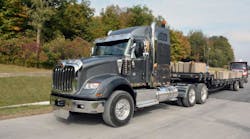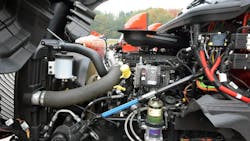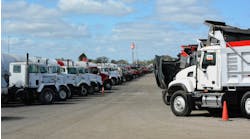NEW CARLISLE, IN. It was a virtual and extended rush hour at Navistar’s 675-acre proving grounds this week as the OEM showcased a variety of its brand new and recently upgraded truck and tractor models during a special ride and drive event for journalists.
The facility’s three-mile, three-lane oval, and its fearsome durability severe service route challenged all-new International HV Series utility, dump and day cab models, alongside upgraded versions of the OEM’s HX Series trucks, introduced back in February of 2016, plus the LT linehaul and RH regional model tractors, introduced in September of 2016 and April of 2017, respectively.
Navistar executives were very bullish on what the future holds where those trucks are concerned and especially concerning the new partnership with Volkswagen – cemented just this past March – which will provide additional engineering know-how to keep making them better.
“These products are about putting the driver first,” explained Denny Mooney, Navistar’s senior vice president of global product development. “We know there’s a driver shortage in the industry and we have really tried to make these trucks what they want to drive. When we talk to our big fleet customers they tell us, ‘if our drivers don’t want to drive your trucks, we’re not going to buy your trucks.’ You can have great fuel economy, you can have great attributes, but at the end of the day, drivers have to want to drive them.”
For example, when Navistar began upgrading its LT Series tractor, Mooney said the OEM held a lot of driver clinics to find what they liked or didn’t like about the truck. “What I like as an engineer might not be what drivers like,” he stressed.
Mooney also pointed to new technology improvements designed to appeal to drivers and fleets alike.
“New [air] disc brakes fit into this driver-first philosophy,” he said. “The trucks are easier to drive. Disc brakes aren’t as ‘grabby’ as the old drum brakes. The life of a disc brake is longer, and some of the fleets are starting to realize it. Our disc brake penetration has doubled in the last two years. We made them standard on the LT in June of this year.”
He emphasized that demand for collision mitigation systems are starting to take off as well. “We made it standard on the LT when we launched it last year,” Mooney said. “Predictive cruise control is another technology starting to take hold. It looks ahead two to three miles and judges the topography of the road, deciding what speed and shifts to be in, and there’s real-world fuel economy improvement.”
Navistar also showcased its new 12.4-liter A26 engine in two tractors for test drives – one cranking out 450 hp and 1,700 lb.-ft. of torque in a 6x4 LT Series tractor equipped with a 56-in. sleeper and the other rated at 400 hp and generating 1,750 lb.-ft. of torque in a 6x4 RH daycab model.
The company said the A26 is 5% more fuel-efficient than its previous 12.4-liter unit, with oil change intervals increased up to 70,000 miles.
“We put a new turbocharger on it,” noted Mooney. “It’s a single turbo where we used to have a twin turbo. It’s a simpler turbo, a VGT [variable geometry turbocharger]. It’s got low-end and high-end power.”
The whole philosophy, he explained, is to simplify the engine – make it easier to service, less complex, and with less weight.
“It’s the lightest big bore engine in the market. It’s also a great vocational engine,” Mooney added. “Those types of trucks love light weight, like cement mixers, etc.”
David Majors, Navistar vice president of product development, told Fleet Owner that part of the OEM’s new design philosophy is to “use a lot of the same switches, dials and gauges clustered from the LT launch, to maximize the usage and volume of those parts.”
That way, fleets that operate multiple vehicles will have “a very common interior” for them to use, he added.
Heating, ventilation and air conditioning or “HVAC” upgrades also proved to be a major engineering focal point, Majors explained.
“We’ve improved the air conditioning units, with five vents, so if you have a bench seat the center passenger is comfortable,” he said. “The HVAC system has been completely redesigned so the defrost performance is best in class.”
Steve Gilligan, Navistar’s vice president of product and vocational marketing, said the company is particularly excited about its new HV trucks.
“We led with the LT, followed with the RH, and now the HV, and in a few months there will be the MVs,” he said. “So we’re on a plan to update every model.”
From an economic standpoint, Gilligan said Navistar is projecting a “really strong” construction market going forward.
“We have seen quite a bit of growth in daycab, seen it accelerate faster than sleeper, and we’re also seeing construction and off-highway growing faster as well,” he pointed out. “And that’s before any sort of stimulus plans. It all bodes well for 2018.”
Jeff Sass, Navistar’s senior vice president for North America truck sales and marketing, expressed further confidence going forward regarding the overall volume for truck sales.
“Medium-duty is up three-ish percent [in sales], and Class 8s up half a point year-over-year,” he said. “I see the economy being strong in 2018, freight rates going up and it being a big year for manufacturing. Fleets say they have more loads than drivers. They tell me they’ll buy every truck we can sell that has a driver in it.”





